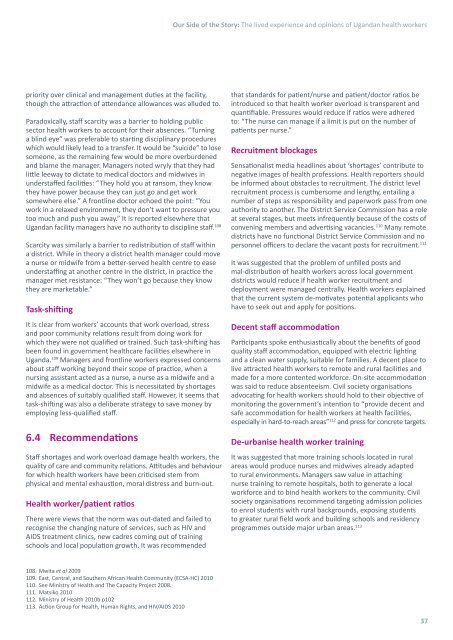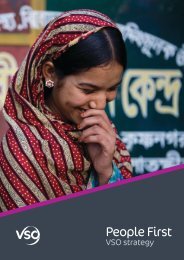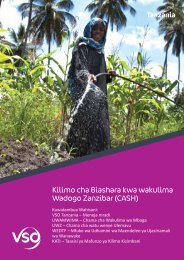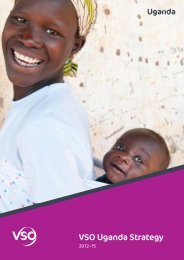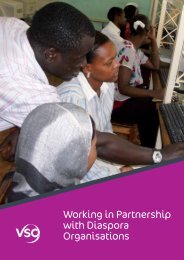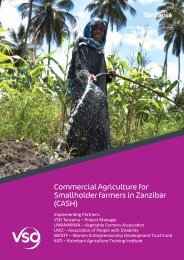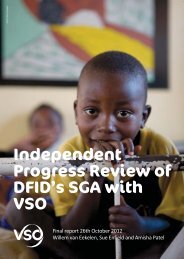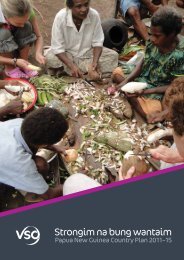<strong>Our</strong> <strong>Side</strong> <strong>of</strong> <strong>the</strong> <strong>Story</strong>: The lived experience and opinions <strong>of</strong> Ugandan health workersHealth centre workers realised that no respite in long shiftsled to community complaints about harsh language: “We work<strong>the</strong> whole day without resting, and in <strong>the</strong> late afternoon weget tired and <strong>the</strong>n we change face.” Staff working set hourshad met some hostility from local people who assumed <strong>the</strong>health centre was closed to outpatients when <strong>the</strong>y saw healthworkers socialising toge<strong>the</strong>r towards <strong>the</strong> end <strong>of</strong> <strong>the</strong> workingday. The staff <strong>the</strong>re pointed out that <strong>the</strong>y worked hard to serveoutpatients quickly and so deserved some rest-time afterpatients had stopped arriving. It was also hard to make waitingpatients understand that health workers were not resting when<strong>the</strong>y sat completing paperwork.Health workers in sole charge <strong>of</strong> patients faced a dilemma:go hungry or leave <strong>the</strong> patients alone? Doing <strong>the</strong> latter wasreported to have brought unfortunate consequences for staffwho were arrested for neglect <strong>of</strong> duty. It was said that <strong>the</strong>arrests were motivated by local political candidates seekingto gain electoral favour through discrediting ruling politicianswith oversight <strong>of</strong> <strong>the</strong> facility. Clinical <strong>of</strong>ficers can be left aloneto cover an entire health centre, running from one departmentto ano<strong>the</strong>r. So it was deeply upsetting when a patient arrived,assumed no staff were available, and called on a local leaderwho <strong>the</strong>n complained to higher authorities.The lack <strong>of</strong> a medical doctor rebounded on o<strong>the</strong>r staff: “When<strong>the</strong> patient dies, <strong>the</strong> community look on you as a bad personwho refused to treat <strong>the</strong> patient.” Lack <strong>of</strong> a midwife or qualifiednurse meant that nursing assistants carried out deliveries. Theyfound it hard to convince patients to put <strong>the</strong>ir trust in <strong>the</strong>m,especially as <strong>the</strong>y <strong>the</strong>mselves recognised <strong>the</strong>y lacked <strong>the</strong> fullrange <strong>of</strong> knowledge to save pregnant women in difficulty.6.3 Factors contributing to understaffingand work overloadIt is important to understand <strong>the</strong> structural causes <strong>of</strong>inadequate staff numbers in government health facilities. Itis not necessarily <strong>the</strong> case that <strong>the</strong>re is a shortage <strong>of</strong> healthworkers available in <strong>the</strong> labour force; some governmentsector managers were aware <strong>of</strong> huge numbers <strong>of</strong> applicantsfor advertised vacancies, while o<strong>the</strong>rs said <strong>the</strong>y had failed torecruit. Among managers at district level, views were expressedthat decentralisation <strong>of</strong> <strong>the</strong> health system was to blame for <strong>the</strong>uneven distribution <strong>of</strong> health workers in local government.Recruitment barriersGovernment sector managers explained that financial allocationsfor salaries stood in <strong>the</strong> way <strong>of</strong> recruiting more staff: <strong>the</strong>re wassimply no money in <strong>the</strong> pot to pay more health workers. Evenif funds were made available to fill authorised posts, vacanciesremained due to bureaucratic procedures and <strong>the</strong> absence <strong>of</strong>a District Service Commission tasked with recruiting healthpersonnel to <strong>the</strong> district.Managers explained why remote and rural facilities found ithard to recruit and retain medical doctors, nurses and midwives.They sympathised with new recruits who turned round and leftfor want <strong>of</strong> something to do in a village: “They post someoneout <strong>the</strong>re in <strong>the</strong> wilderness and <strong>the</strong>y expect <strong>the</strong>m to work!” Withno electricity for TV and internet, people were “not connectedto <strong>the</strong> world”. Poor roads and no public transport at night leftstaff “stuck”. Free staff accommodation was widely believed tomake it easier for nurses and medical doctors to leave behind<strong>the</strong> amenities <strong>of</strong> town life. Poor-quality staff quarters, on <strong>the</strong>o<strong>the</strong>r hand, were a deterrent to taking up and staying in posts.An example was cited <strong>of</strong> rented accommodation <strong>of</strong> so poor astandard that it was not safe to raise a child <strong>the</strong>re, leading toa nurse leaving her post. Health workers living in towns spokealong similar lines, adding that <strong>the</strong> cost <strong>of</strong> food was high inremote areas and educational standards poor.It was remarked that medical doctors dislike working in villagesbecause <strong>of</strong> <strong>the</strong> lack <strong>of</strong> opportunity for learning and careeradvancement. It was also said that medical doctors avoid jobsat district level because local politicians misuse health serviceresources and interfere in treatment decisions.Local management factorsIn <strong>the</strong> local government sector <strong>the</strong> problems <strong>of</strong> overwork andtoo little time <strong>of</strong>f stemmed in part from limited managementcapacity to draw up fair duty rosters. It was noted that poorlyplanned rosters scheduled nurses to work back-to-back day andnight shifts. The view among nurses was that properly organisedtime <strong>of</strong>f would motivate <strong>the</strong>m to work. Concerned healthcentre managers said <strong>the</strong>y recognised <strong>the</strong> need to manage staffhours fairly, but with so few staff that was almost impossible.Government sector managers explained how unexpectedabsences worsened <strong>the</strong> load on nursing staff. When staffdid not turn up for work, and especially when <strong>the</strong>y didnot communicate <strong>the</strong>ir intent, managers struggled to findworkers to fill <strong>the</strong> gaps and patients were left waiting. While<strong>the</strong>re was sympathy among managers for <strong>the</strong> personal andfamily problems that kept staff from work, <strong>the</strong>re were als<strong>of</strong>eelings that <strong>the</strong> reasons <strong>of</strong>fered were not always genuine.In Ugandan culture, it was hard to question whe<strong>the</strong>r familysickness or burials had actually occurred and hard to enforcea requirement to produce sick notes. Sometimes managerssuspected, or even knew, that absent staff were “moonlighting”or pursuing a “side income”, “doing o<strong>the</strong>r things to survive”.Managers and frontline workers commented that staff wholived on site were rarely absent, unless <strong>the</strong>y were sick or arelative had a problem, as <strong>the</strong>y would be ashamed whenpatients came looking for <strong>the</strong>m at home.Participants working in government health centres explainedhow <strong>the</strong>ir hours and workload increased at short noticewhen senior colleagues were called away to workshops andmeetings. They rarely questioned why <strong>the</strong>se activities took36
<strong>Our</strong> <strong>Side</strong> <strong>of</strong> <strong>the</strong> <strong>Story</strong>: The lived experience and opinions <strong>of</strong> Ugandan health workerspriority over clinical and management duties at <strong>the</strong> facility,though <strong>the</strong> attraction <strong>of</strong> attendance allowances was alluded to.Paradoxically, staff scarcity was a barrier to holding publicsector health workers to account for <strong>the</strong>ir absences. “Turninga blind eye” was preferable to starting disciplinary procedureswhich would likely lead to a transfer. It would be “suicide” to losesomeone, as <strong>the</strong> remaining few would be more overburdenedand blame <strong>the</strong> manager. Managers noted wryly that <strong>the</strong>y hadlittle leeway to dictate to medical doctors and midwives inunderstaffed facilities: “They hold you at ransom, <strong>the</strong>y know<strong>the</strong>y have power because <strong>the</strong>y can just go and get worksomewhere else.” A frontline doctor echoed <strong>the</strong> point: “Youwork in a relaxed environment, <strong>the</strong>y don’t want to pressure youtoo much and push you away.” It is reported elsewhere thatUgandan facility managers have no authority to discipline staff. 108Scarcity was similarly a barrier to redistribution <strong>of</strong> staff withina district. While in <strong>the</strong>ory a district health manager could movea nurse or midwife from a better-served health centre to easeunderstaffing at ano<strong>the</strong>r centre in <strong>the</strong> district, in practice <strong>the</strong>manager met resistance: “They won’t go because <strong>the</strong>y know<strong>the</strong>y are marketable.”Task-shiftingIt is clear from workers’ accounts that work overload, stressand poor community relations result from doing work forwhich <strong>the</strong>y were not qualified or trained. Such task-shifting hasbeen found in government healthcare facilities elsewhere inUganda. 109 Managers and frontline workers expressed concernsabout staff working beyond <strong>the</strong>ir scope <strong>of</strong> practice, when anursing assistant acted as a nurse, a nurse as a midwife and amidwife as a medical doctor. This is necessitated by shortagesand absences <strong>of</strong> suitably qualified staff. However, it seems thattask-shifting was also a deliberate strategy to save money byemploying less-qualified staff.6.4 RecommendationsStaff shortages and work overload damage health workers, <strong>the</strong>quality <strong>of</strong> care and community relations. Attitudes and behaviourfor which health workers have been criticised stem fromphysical and mental exhaustion, moral distress and burn-out.Health worker/patient ratiosThere were views that <strong>the</strong> norm was out-dated and failed torecognise <strong>the</strong> changing nature <strong>of</strong> services, such as HIV andAIDS treatment clinics, new cadres coming out <strong>of</strong> trainingschools and local population growth. It was recommendedthat standards for patient/nurse and patient/doctor ratios beintroduced so that health worker overload is transparent andquantifiable. Pressures would reduce if ratios were adheredto: “The nurse can manage if a limit is put on <strong>the</strong> number <strong>of</strong>patients per nurse.”Recruitment blockagesSensationalist media headlines about ‘shortages’ contribute tonegative images <strong>of</strong> health pr<strong>of</strong>essions. Health reporters shouldbe informed about obstacles to recruitment. The district levelrecruitment process is cumbersome and lengthy, entailing anumber <strong>of</strong> steps as responsibility and paperwork pass from oneauthority to ano<strong>the</strong>r. The District Service Commission has a roleat several stages, but meets infrequently because <strong>of</strong> <strong>the</strong> costs <strong>of</strong>convening members and advertising vacancies. 110 Many remotedistricts have no functional District Service Commission and nopersonnel <strong>of</strong>ficers to declare <strong>the</strong> vacant posts for recruitment. 111It was suggested that <strong>the</strong> problem <strong>of</strong> unfilled posts andmal-distribution <strong>of</strong> health workers across local governmentdistricts would reduce if health worker recruitment anddeployment were managed centrally. Health workers explainedthat <strong>the</strong> current system de-motivates potential applicants whohave to seek out and apply for positions.Decent staff accommodationParticipants spoke enthusiastically about <strong>the</strong> benefits <strong>of</strong> goodquality staff accommodation, equipped with electric lightingand a clean water supply, suitable for families. A decent place tolive attracted health workers to remote and rural facilities andmade for a more contented workforce. On-site accommodationwas said to reduce absenteeism. Civil society organisationsadvocating for health workers should hold to <strong>the</strong>ir objective <strong>of</strong>monitoring <strong>the</strong> government’s intention to “provide decent andsafe accommodation for health workers at health facilities,especially in hard-to-reach areas” 112 and press for concrete targets.De-urbanise health worker trainingIt was suggested that more training schools located in ruralareas would produce nurses and midwives already adaptedto rural environments. Managers saw value in attachingnurse training to remote hospitals, both to generate a localworkforce and to bind health workers to <strong>the</strong> community. Civilsociety organisations recommend targeting admission policiesto enrol students with rural backgrounds, exposing studentsto greater rural field work and building schools and residencyprogrammes outside major urban areas. 113108. Mwita et al 2009109. East, Central, and Sou<strong>the</strong>rn African Health Community (ECSA-HC) 2010110. See Ministry <strong>of</strong> Health and The Capacity Project 2008.111. Matsiko 2010112. Ministry <strong>of</strong> Health 2010b p102113. Action Group for Health, Human Rights, and HIV/AIDS 201037


